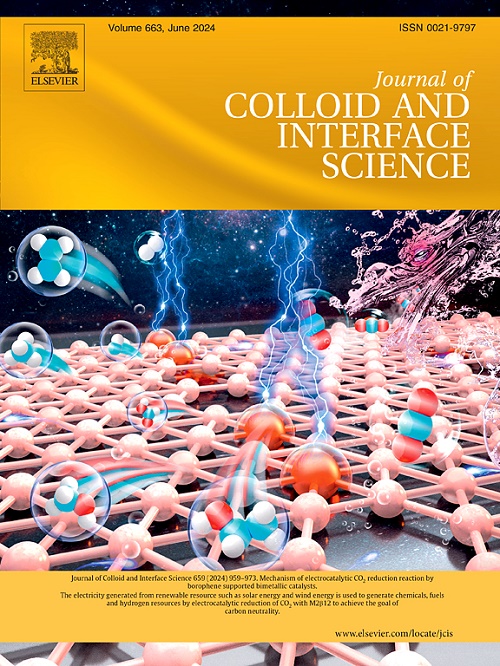Fabrication of core–shell nanostructure via novel ligand-defect reassembly strategy for efficient photocatalytic hydrogen evolution and NO removal
IF 9.4
1区 化学
Q1 CHEMISTRY, PHYSICAL
引用次数: 0
Abstract
The core–shell structure often exhibits unique properties, resulting in superior physical and chemical performance distinct from individual component in the field of photocatalysis. However, traditional prepared methods such as template synthesis and layer-by-layer self-assembly are relatively complex. Therefore, it is necessary to explore an efficient and expedient approach. Here, we have proposed a convenient method to gradually destroy the terephthalic acid (BDC) of MIL-125 from the outer to inner layers through hydrothermal stirring, followed by reassembling with photosensitive 2-amino-terephthalic acid (BDC-NH2) into the exposed Ti-oxo clusters left by the BDC to create photocatalysts featuring a core–shell configuration. The special core–shell sample with the analogous mixture of MIL-125 and MIL-125-NH2 function as a high-performance dual-functional photocatalyst for hydrogen generation and NO elimination. The optimal core–shell material (M-125-45-N) exhibits an outstanding photocatalytic hydrogen production rate of 3.74 mmol·g−1·h−1 and an excellent photocatalytic NO removal rate of 70.15 %. The apparent quantum yield (AQY) value and solar-to-hydrogen energy conversion efficiency (STH) at specific wavelengths are also investigated. The Density functional theory (DFT) calculation, In-situ Fourier transform infrared (In-situ FT-IR) and Electron spin resonance (ESR) have suggested that the enhanced photocatalytic activity of optimal core–shell material arised from its stronger adsorption capacity towards reactants, promoting the production of reactive oxygen species (ROS) conducive to photocatalytic reactions. This study represents the first investigation of a dual functional core–shell MOFs formed via ligand-defect reassembly, showcasing the excellent efficacy in photocatalytic hydrogen evolution and NO removal, which contributes to the feasible development of novel dual-functional photocatalysts with core–shell structures.

通过新型配体-缺陷再组装策略制造核壳纳米结构,用于高效光催化氢气进化和氮氧化物去除。
在光催化领域,核壳结构往往表现出独特的性能,从而获得有别于单个成分的优异物理和化学性能。然而,传统的制备方法(如模板合成和逐层自组装)相对复杂。因此,有必要探索一种高效便捷的方法。在此,我们提出了一种简便的方法,通过水热搅拌将 MIL-125 的对苯二甲酸(BDC)从外层到内层逐渐破坏,然后与光敏的 2-氨基对苯二甲酸(BDC-NH2)重新组装到 BDC 留下的暴露的 Ti-oxo 簇中,从而制备出具有核壳构型的光催化剂。特殊的核壳样品与 MIL-125 和 MIL-125-NH2 的类似混合物可作为一种高性能的双功能光催化剂,用于制氢和消除氮氧化物。最佳核壳材料(M-125-45-N)的光催化制氢率为 3.74 mmol-g-1-h-1,光催化脱氮率为 70.15%。此外,还研究了特定波长下的表观量子产率(AQY)值和太阳能-氢能转换效率(STH)。密度泛函理论(DFT)计算、原位傅立叶变换红外(In-situ FT-IR)和电子自旋共振(ESR)表明,最优核壳材料光催化活性的增强源于其对反应物更强的吸附能力,促进了有利于光催化反应的活性氧(ROS)的产生。本研究首次研究了通过配体缺陷重组装形成的双功能核壳 MOFs,展示了其在光催化氢气进化和脱除 NO 方面的卓越功效,有助于开发新型核壳结构双功能光催化剂。
本文章由计算机程序翻译,如有差异,请以英文原文为准。
求助全文
约1分钟内获得全文
求助全文
来源期刊
CiteScore
16.10
自引率
7.10%
发文量
2568
审稿时长
2 months
期刊介绍:
The Journal of Colloid and Interface Science publishes original research findings on the fundamental principles of colloid and interface science, as well as innovative applications in various fields. The criteria for publication include impact, quality, novelty, and originality.
Emphasis:
The journal emphasizes fundamental scientific innovation within the following categories:
A.Colloidal Materials and Nanomaterials
B.Soft Colloidal and Self-Assembly Systems
C.Adsorption, Catalysis, and Electrochemistry
D.Interfacial Processes, Capillarity, and Wetting
E.Biomaterials and Nanomedicine
F.Energy Conversion and Storage, and Environmental Technologies

 求助内容:
求助内容: 应助结果提醒方式:
应助结果提醒方式:


